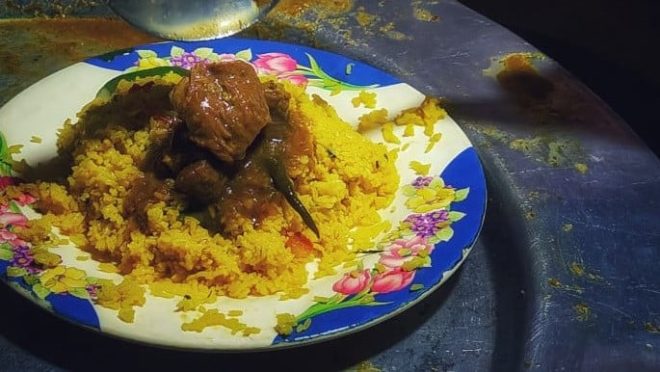78 years of flavour: The story of Manik Chan's polao in Old Dhaka
78 years of flavour: The story of Manik Chan's polao in Old Dhaka

The air around Digu Babu Lane in Old Dhaka is usually filled with the aroma of Manik Chan’s polao.
Beside a huge pot, a large ladle in hand, stands Manik Chan himself, wearing a lungi, short in stature, with an unassuming face and a physique that shows his love of food.
His son, Sukh Chan, handles the polao while an assistant busily packs parcels.

It looks like a small restaurant scene – except there is no restaurant: Manik Chan’s polao does not have a shop.
Among Bangladesh’s food lovers, Old Dhaka’s traditional dishes hold a special place, and Manik Chan’s polao is one of them. Even without a permanent shop, people come from far and wide just to experience its flavour.
How it began
It all started in the early days of Pakistan. Manik Chan’s father, Mia Chan, was a hobbyist cook. To supplement his meagre income, he began cooking at night on Digu Babu Lane. Truck drivers returning late from unloading goods would stop for his food, paying him a few coins.
Before long, his makeshift “hotel” became a lifeline for night guards and other night-shift workers.
But could one even call it a hotel? There was no roof; just open sky and a raised brick platform for the pots. A few basic utensils, a single menu: polao and mutton curry.
Two annas a plate
At the time, biryani was just beginning to gain popularity. Mia Chan learned cooking from a local biryani maker. With little capital but a lot of passion, he started small: cooking for eight to 10 people, charging two annas per serving, which was not cheap in those days.
Eating outside the home was a new concept back then. As time passed, Mia Chan’s customers grew in number, and within a few years he became a familiar face in the neighbourhood.
As a child, Manik Chan used to tag along, watching his father cook, serve and count the day’s earnings.

By the 1980s, Mia Chan’s polao and mutton cost around Tk10-Tk12, when mutton itself cost Tk50 per seer (~933 grams). For low-income people, buying meat was a luxury. They would save up and come to Mia Chan’s stall for a special treat.
As his father aged, Manik Chan began helping more, eventually taking over entirely. When Mia Chan passed away, the stall remained, and with it, the unmistakable aroma of his cooking.
Manik Chan had no idea how long he could sustain it. But hardship had taught him resilience. He married off three sisters, cared for his mother, started his own family and educated his children – all through his cooking. The family business is now around 78 years old.
Six days, six menus
At first, Manikchan followed his father’s simple routine: polao and mutton every day. But daily repetition grew dull, so he introduced a six-day rotation: each day a different recipe, all inherited from his father.
Saturday: Polao with mutton rezala; Sunday: Spicy mutton and potato curry with polao; Monday: Mutton bhuna polao; Tuesday: Polao with mutton and booter dal; Wednesday: Mutton biryani; and Thursday: Mutton bhuna khichuri.
Friday is the only day his ladle stays still.
One trademark of Manik Chan’s stall is its affordability: just Tk200 for a hearty meal, with generous portions of polao and large chunks of meat.

Changing with the times
Until two years ago, Manik Chan’s Polao was a late-night ritual – serving from 3am till dawn on Digu Babu Lane, where crowds of night owls gathered. But women were rarely seen there, as midnight trips to Old Dhaka were not feasible for many.
Last year, Manik Chan adjusted his hours. Now he serves between 9pm and 11:30pm. That change opened the door for female customers, too.
Social media wave
Food vloggers have made Manik Chan’s polao a household name, with YouTube and Facebook videos carrying its fame far beyond Dhaka.
But viral videos can also inflate expectations unfairly. After all, Manik Chan’s polao is not meant to rival fancy restaurant dishes.
One customer put it best: “If you expect a five-star dining experience in Old Dhaka’s narrow alleys, you will be disappointed. But for the price, Manik Chan’s polao beats most average meals hands down.”

Three generations
Manik Chan’s son is gradually taking over the business and learning the family recipes.
Aged and weary, Manik Chan often drifts into nostalgia, remembering his father, those old pots and ladles, the open-air kitchen that fed three generations.
His son Sukh Chan dreams of expanding, perhaps someday having a small space with a roof, a few tables and a sign that reads “Manik Chan’s Polao.”
But Manik Chan himself is not convinced. With a smile, he says, “If I start paying rent and overhead, I will not be able to keep prices this low. And eating under the open sky, that joy would be lost.”


